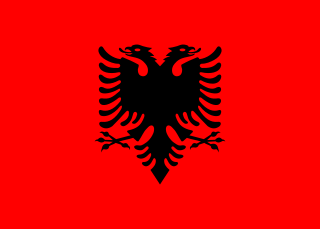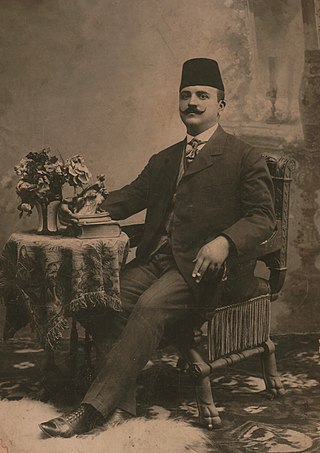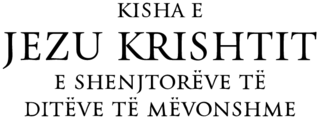Related Research Articles

Tirana is the capital and largest city of Albania. It is located in the centre of the country, enclosed by mountains and hills with Dajti rising to the east and a slight valley to the northwest overlooking the Adriatic Sea in the distance. It is among the wettest and sunniest cities in Europe, with 2,544 hours of sun per year.

The flag of Albania depicts a silhouetted black double-headed eagle in the center of a red background. The red stands for bravery, strength, valour and bloodshed, while the Eagle represents the sovereign state of Albania. The flag was established as the national flag of Albania when the country gained its independence from the Ottoman Empire in 1912.

Tourism in Albania has been a key element to the country's economic activity and is constantly developing. Albania is characterized by its rich archaeological and cultural heritage dating back to the classical period when Illyrians and Ancient Greeks inhabited the region. Over the course of history, the territory of Albania was occupied and populated by Romans, Byzantines, Venetians and Ottomans. Notably the country features unspoiled beaches, mountainous landscapes, traditional cuisine, archaeological artifacts, unique traditions, low prices and the wild atmosphere of the countryside.

The Congress of Lushnjë, historically documented by the name Mbledhja Kombiare Lushnje, was a conference of Albanian political leaders held from January 21 to January 31, 1920, in Lushnjë, Albania.

Districts were first and second-level administrative divisions of Albania from 1913–2000. Their number, size, and status changed over time. From 1991 to 2000, the 36 districts were organized into 12 counties. Pursuant to the 1998 Constitution and Law No. 8653, the districts were abolished and replaced with the larger counties and smaller municipalities.

Krujë is a town and a municipality in north central Albania. Located between Mount Krujë and the Ishëm River, the city is 20 km north of the capital of Albania, Tirana.

Hekurudha Shqiptare or HSH(Albanian Railways) is the state-owned operator of the Albanian railway system and became a private company in 2005. The system's main passenger terminal was Durrës railway station in the port city of Durrës.

The Principality of Albania was a short-lived monarchy in Albania, headed by Wilhelm, Prince of Albania, that lasted from the Treaty of London of 1913 which ended the First Balkan War, through the invasions of Albania during World War I and the subsequent disputes over Albanian independence during the Paris Peace Conference of 1919, until 1925, when the monarchy was abolished and the Albanian Republic declared.

Mufid Bey Libohova was an Albanian economist, diplomat and politician and one of the delegates at the Assembly of Vlorë where the Albanian Declaration of Independence took place. He served as the first Minister of Interior of Albania, during the Provisional Government of Albania. He held different government positions on nine occasions between 1913–1927, holding the positions of Justice Minister, Minister of the Interior, Minister of Finances, and Minister of Culture.
Postal Codes in Albania consist of 4 digits; the first two digits show the branch on a district level located at the center of that administrative level, whereas the second two digits show the postal office offering service to a defined administration unit on a municipality level:
The regions of Albania—apart from the official present and historical administrative divisions—include the following:

Albanian wine is produced in several regions throughout Albania within the Mediterranean Basin. The country has one of the oldest wine making traditions, dating back at least 3000 years ago to the Bronze Age Illyrians. It belongs chronologically to the old world of wine producing countries.
The Albanian local elections in 1992 was the first local election held in Albania. The elections were held on 26 July 1992 and the general winner was the coalition Socialist Party of Albania with 49.87% of the vote. The Democratic Party of Albania however, won in capital of Tirana.
The Congress of Berat, also known as the Albanian Orthodox Congress, was a meeting held on 13 September 1922, in Berat, Albania, among Albanian Orthodox faithful. The congress decided the autocephaly of the Church of Albania. According to the decisions of the Congress, religious services could be held in the Albanian language.

The Highways in Albania are the central state and main transport network in Albania. The motorways and expressways are both part of the national road network. The motorways are primary roads with a speed limit of 110 kilometres per hour (68 mph). They have white on green road signs such as in Italy and other countries nearby. The expressways are the secondary roads, also dual carriageways, but without an emergency lane. They have a speed limit of 90 kilometres per hour (56 mph). They have white on blue road signs.

The Albanian Adriatic Sea Coast stretches in the south-eastern Adriatic Sea beginning at the Gulf of Drin in the north, across the port cities of Shëngjin, Durrës, and Vlorë, to the Bay of Vlorë in the south, where the Albanian Riviera as well as the Albanian Ionian Sea Coast begins.

The Church of Jesus Christ of Latter-day Saints has been present in Albania since at least the early 1990s. In 1993, there were approximately 100 members in the country. In 2022, there were 3,314 members in 14 congregations.
